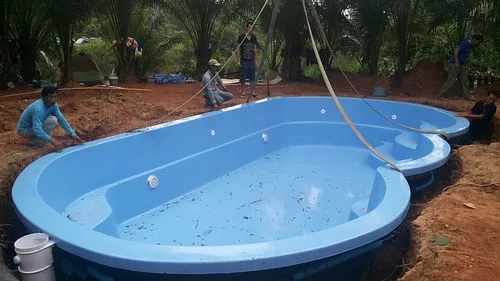Introduction:
Fiberglass pool molds are a critical component in the construction of modern swimming pools, offering a blend of durability, customization, and aesthetic appeal. As homeowners increasingly seek out low-maintenance, long-lasting pool options, understanding the role of fiberglass pool molds in the manufacturing process becomes essential. In this comprehensive guide, we’ll explore what fiberglass pool molds are, how they are used, and the numerous benefits they provide.

fiberglass pool molds
What Are Fiberglass Pool Molds?
Fiberglass pool molds are large, pre-shaped forms used to create fiberglass pools. These molds come in various shapes and sizes, allowing manufacturers to produce a wide range of pool designs. The mold serves as the foundation onto which layers of fiberglass and resin are applied to create a solid, seamless structure.
Fiberglass pools are known for their strength and longevity. The mold ensures a consistent thickness and structure, making the pool resistant to wear and tear. One of the significant advantages of fiberglass molds is the ability to customize the shape and size of the pool. Whether you want a classic rectangular pool or a unique freeform design, molds can be tailored to meet specific requirements.
The Manufacturing Process of Fiberglass Pools
The manufacturing process begins with the creation of a mold, which is meticulously crafted to ensure precision. Layers of fiberglass are applied to the mold, followed by a coating of resin. This combination is then left to cure, forming a durable, non-porous shell. Once cured, the shell is removed from the mold, ready for installation.
- Preparation of the Mold: The mold is cleaned and prepped to ensure a smooth application of fiberglass.
- Application of Gelcoat: A gelcoat is applied to the mold to create a smooth surface and provide color to the pool.
- Fiberglass Layering: Multiple layers of fiberglass are applied, ensuring strength and durability.
- Curing: The layered mold is left to cure, forming a solid structure.
- Demolding: The cured shell is carefully removed from the mold.
- Final Touches: Any necessary finishing touches are added before the pool is transported for installation.
Advantages of Using Fiberglass Pool Molds
Durability:
Fiberglass pools are known for their strength and longevity. The mold ensures a consistent thickness and structure, making the pool resistant to wear and tear.
Customization:
One of the significant advantages of fiberglass molds is the ability to customize the shape and size of the pool. Whether you want a classic rectangular pool or a unique freeform design, molds can be tailored to meet specific requirements.
Smooth Finish:
The smooth surface of a fiberglass pool, achieved through the mold, is non-porous, which helps prevent algae growth and reduces maintenance.
Types of Fiberglass Pool Molds
There are various types of molds used in the industry, each serving different purposes. Standard molds offer popular shapes and sizes, while custom molds allow for unique designs tailored to individual preferences. Custom molds, though more expensive, provide unparalleled flexibility in pool design.
- Standard Molds: Common shapes and sizes that are widely used in the industry.
- Custom Molds: Tailored to specific design preferences, offering unique shapes and features.
Installation and Maintenance
Fiberglass pools are relatively easy to install compared to other types. The pre-formed shell is transported to the site and set into the excavated area. Proper maintenance, including regular cleaning and chemical balancing, ensures the pool remains in top condition for years to come.
- Site Preparation: Excavation and preparation of the site.
- Shell Installation: Placement of the fiberglass shell into the prepared site.
- Plumbing and Electrical: Installation of necessary plumbing and electrical components.
- Backfilling: Backfilling around the pool shell to secure it in place.
- Finishing Touches: Adding decking, landscaping, and other finishing elements.
Market Trends and Innovations
The fiberglass pool industry continues to evolve with new trends and innovations. Advances in mold technology have led to more intricate designs and features, enhancing the overall pool experience. Environmentally friendly materials and energy-efficient designs are also gaining popularity.
- Innovative Designs: New mold designs offering unique features and shapes.
- Eco-Friendly Materials: Use of sustainable materials in pool construction.
- Energy Efficiency: Incorporation of energy-efficient technologies in pool systems.
Conclusion
Fiberglass pool molds play a pivotal role in the creation of modern swimming pools, offering a combination of durability, customization, and ease of maintenance. As the market continues to grow, understanding the benefits and process of using fiberglass pool molds can help homeowners make informed decisions. Consider exploring the various options available and take the plunge into owning a beautiful, long-lasting fiberglass pool.




























